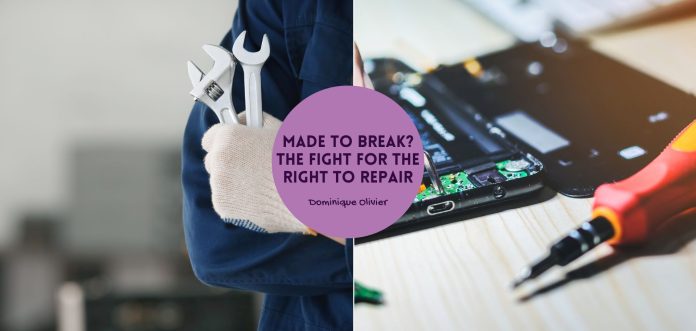The future is fixable – at least, that’s what consumers would like to see. Big businesses are still digging in their heels when it comes to open repairs, but new legislation may be increasing pressure soon.
For as long as people have been making things, they’ve also been finding ways to sell us the next version of those things. Take Apple, for example. In the 17 years since the first iPhone launched in 2007, the company has released 29 versions of their flagship smartphone. In late 2017, iPhone users discovered that older models were slowing down after iOS updates, sparking accusations that Apple was deliberately throttling performance to drive sales of new phones.
Apple denied this (of course), explaining that the feature was designed to prevent unexpected shutdowns by managing the strain on degraded lithium-ion batteries. To address the backlash, they introduced an iOS update allowing users to disable the throttling feature (though they advised against it) and launched a battery replacement programme, reducing the service cost from $79 to $29 for six months. The catch? Batteries could still only be bought and installed at Apple stores, ensuring that Apple retained its monopoly over every phase of the iPhone consumer’s journey.
From a business perspective, this seems like a great strategy – especially if your business makes expensive goods that could last a long time before needing to be replaced. But how long will cash-strapped, conscious consumers continue to put up with planned obsolescence? And will the growing repair economy (and increasing right to repair legislation) force businesses to rethink their ways?
Made to replace
Though there is no evidence that he was the first to come up with this idea, one of the most influential players in the quick-replacement game was Alfred P. Sloan, an executive at General Motors way back in the 1920s. Alfred didn’t just embrace obsolescence: he turned it into a finely tuned business strategy. Under Sloan’s leadership, GM decided that the best way to keep customers coming back wasn’t just making reliable cars but by making them feel outdated within a year or two. By introducing annual updates to car models, with tweaks to style, features, or performance, GM created a perpetual cycle of desire. Consumers weren’t just buying transportation; they were an antidote to the fear of falling behind.
By constantly dangling the “next big thing” in front of consumers, GM not only drove up sales but reshaped the American car market entirely. Competitor Ford, which had built its empire on the rock-solid dependability and affordability of the Model T, suddenly found itself playing catch-up. Consumers who had once been content with a car that “just worked” were now being wooed by sleeker designs, brighter colors, and features they didn’t even know they needed. GM’s strategy proved so effective that by the 1930s, it had overtaken Ford as the largest automaker in the United States, cementing planned obsolescence as not just a marketing tactic but a cornerstone of modern capitalism.
Ford may have been in the backseat when it came to releasing new models, but they owned the after-sales journey. Back in the 1910s, Ford created a network of certified dealerships and service centers, encouraging customers to use genuine Ford parts rather than turning to independent mechanics or aftermarket suppliers. To tighten control further, Ford pushed for standardised pricing, enforcing flat fees for repairs across their network. It was a win for Ford, but a major headache for small repair shops, which struggled to keep up with constantly changing parts, most of which were exclusively provided to Ford service and repair centres.
In 1947, one enterprising business owner had the bright idea of refurbishing old spark plugs and reselling them. The problem was that he was selling them under a trademarked brand name, which landed him in legal hot water. This case, Champion Spark Plug Co. v. Sanders, would go on to shape the rules for how repaired or refurbished goods could be sold. While the business owner was rapped on the knuckles for copyright infringement, the court’s decision upheld the right to resell repaired or refurbished items, as long as they were clearly labeled to avoid misleading consumers. This ruling laid the groundwork for modern Federal Trade Commission guidelines on resale practices.
Let the people repair
In the early 2000s, the automotive industry successfully shut down the first attempt to pass a right-to-repair bill tailored to its sector. It was a decisive win for car manufacturers, who had little interest in making repairs easier for anyone outside their authorised networks. They pointed to the National Automotive Service Task Force (NASTF), an industry-backed organisation that launched an online directory to provide access to manufacturer information and tools. Progress, right? Not so fast. A study by the Terrance Group revealed that, despite the NASTF, nearly 59% of independent repair shops were still struggling to get hold of diagnostic tools and parts. In short, the directory was more PR than practical help.
Meanwhile, cars themselves were becoming harder to fix. As technology continued to evolve, the share of electronic components in cars skyrocketed, from just 5% in the 1970s to over 22% by 2000. Hybrid cars, while revolutionary, made things even trickier. They required specialised tools and software that manufacturers shared only with their authorised repair services. Independent mechanics were increasingly boxed out, left grappling with limited resources while trying to stay relevant in an industry moving faster than they could catch up.
Despite these challenges, the push for a right to repair didn’t fade. Initially driven by automotive consumer protection agencies and after-sales service providers, the movement soon crossed over into other industries. As gadgets like smartphones and computers became ubiquitous, the demand for repairability gained even more momentum. Even farmers joined the fray, fighting for the ability to fix their increasingly tech-heavy equipment without paying steep fees to manufacturers. Climate change activists weren’t far behind, arguing that repairing products rather than replacing them could help curb the growing e-waste crisis.
What started as a niche debate in the auto industry became a global movement, challenging the idea that manufacturers should hold a monopoly on repair. But the fight was (and still is) far from over.
A long way to go – but some progress on the way
In the United States, 20 states are currently considering legislation aimed at giving consumers more power to fix their stuff. The scope varies – some bills focus on everyday gadgets, while others target farm equipment and cars. Unsurprisingly, the pushback from big players like Apple, Microsoft, and Dyson has been fierce, with lawsuits keeping much of this legislation tied up in courts for years.
Across the Atlantic, the European Union has taken a more decisive approach. A new EU directive now mandates manufacturers to design products with sustainability in mind. Think less waste, lower energy consumption, and easier repairs. Crucially, they’re also required to guarantee spare parts for up to 10 years for products like white goods and lighting. It’s all part of the EU’s broader mission to create a sustainable, circular economy where products are reused, not just tossed away. Down in Australia, the Bower Reuse & Repair Centre is leading the charge for similar reforms. They argue that a truly sustainable future hinges on embracing a circular economy, and at the heart of that is the right to repair.
South Africa may be playing catch-up with the EU when it comes to repairing consumer electronics, but the motoring industry has seen meaningful progress on the right-to-repair front. Thanks to persistent advocacy by the local chapter of the Right to Repair Campaign, the Competition Commission introduced new guidelines in July 2021. These rules are designed to shake up the vehicle repair industry and give consumers more options. Whether you want to take your car to an independent mechanic or roll up your sleeves and handle the repairs yourself, these guidelines aim to make it easier (and fairer) for you to do just that.
With mounting support from consumers, independent repairers, and environmental advocates, the repair economy is poised to reshape how we think about ownership and consumption. The question now is whether industries will adapt willingly or continue to resist as the demand for repairable, sustainable products becomes impossible to ignore.
About the author: Dominique Olivier

Dominique Olivier is the founder of human.writer, where she uses her love of storytelling and ideation to help brands solve problems.
She is a weekly columnist in Ghost Mail and collaborates with The Finance Ghost on Ghost Mail Weekender, a Sunday publication designed to help you be more interesting.
Dominique can be reached on LinkedIn here.





Interesting!
You might just find the it not so plain sailing when one takes one’s two year old vehicle to a RMI accredited workshop for a service. In terms of the new regulations, lastsaid should not void one’s manufacturerers warrantee. In real life it is a whole different kettle of fish as one then finds that one has inadvertently got involved with a series of smoke screens, not of one’s own making!
Thanks,
Mike
Nice article!
I’ve used iFixit to repair my Apple products for many years. Their manifesto (https://www.ifixit.com/Manifesto) echoes the sentiments in your article. I even built a Lego stand to hold the screen while replacing the iPhone’s battery. It’s fun to do it yourself 😁